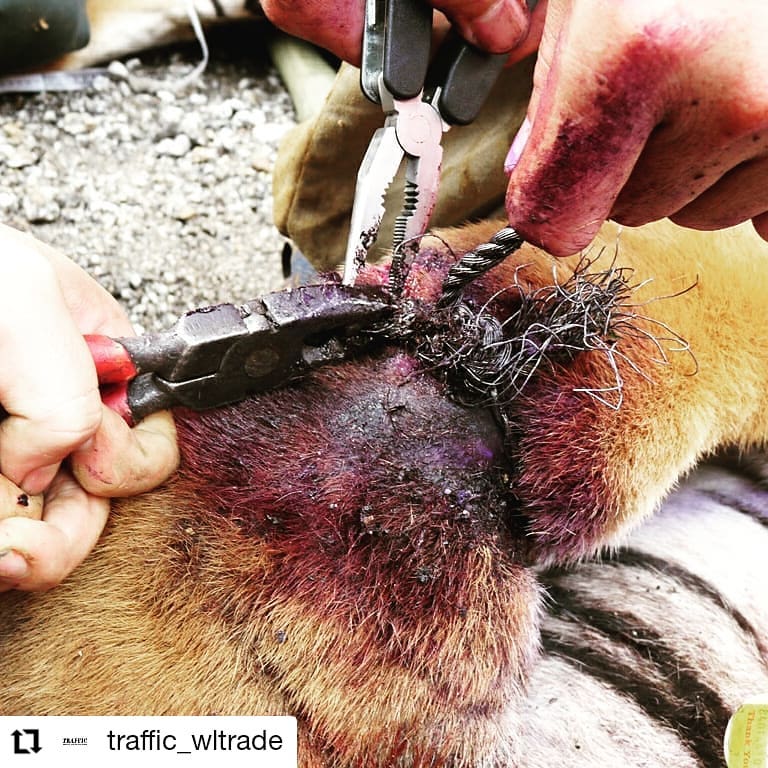
2020 has become a “do or die” moment for the Malayan tiger.
With less than 200 individuals left in the wild, a shrinking number of suitable habitats and a seemingly endless array of wannabe poachers trying to make a quick buck, our local tiger species is on the verge of disappearing forever.
According to WWF-Malaysia’s Tiger Lead Dr. Mark Rayan Darmaraj, the situation might already have already reached the point of no return. Without immediate and drastic measures, he predicts that Malaysia’s tiger population would go extinct within three to four years.
By 2025, the only living tigers in Malaysia might be the ones in zoos.
So How Did It Get to This Point?
Back in the 1950s, there were over 3,000 tigers living in Malaysia. By 2003, this number had dropped to around 500. And today, it is estimated that there are less than 200 wild tigers living in Malaysia.
There are a number of reasons behind this drastic decline:
Poaching

The number one threat to the Malayan tiger comes from illegal wildlife trading. Tiger populations all across the world have plummeted as poachers receive more and more money to meet this demand.
Asia’s traditional medicine market in particular has an insatiable appetite for tiger body parts including skin, bone and sexual organs. Unscrupulous wildlife traders have been known to keep tiger bones as trophies, serve tiger meat in exotic dishes and even create “magic” potions made from tiger testes because they believe that it will improve their sexual prowess.
But despite years of effort from government agencies such as the Department of Wildlife and National Parks (PERHILITAN), it is difficult to find realistic information on the number of active poachers operating in our country. For every poacher that gets caught, several others are believed to successfully escape from the authorities.
Habitat Loss

Over the last century, Malaysia has lost a majority of its lowland forests. This has had drastic impacts on many large mammals, including the Malayan tiger.
Aside from that, deforestation also leads to fragmentation; new roads, pipelines and railways are built through formerly pristine forests, splitting them apart and making it harder for tigers to maintain the territory they need to survive.
Without a large forest range to hunt and mate in, tigers are forced into increasingly smaller spaces, with some of them even becoming marooned on “habitat islands”, cut off from meeting and mating with other tigers. Without a suitable habitat, even tigers that were raised in captivity cannot be safely released back into the wild.
Human-Tiger Conflict

The more forests we cut down, the more likely tigers are forced to move into human territory, simply because there’s nowhere else for them to go.
Between 1991 and 2006, there were approximately 2,398 complaints about human-tiger conflicts. These included extreme events like tigers attacking humans or livestock, but even cases of tigers being sighted by villagers were reported.
One of the biggest issues with human-tiger conflicts involve farmers who hunt or kill wild animals in order to protect their own livestock. Tigers can fall prey to measures such as snares and traps — even if the person who set them was actually trying to catch other animals such as wild boar.
Competition with Human Hunters

Speaking of wild boar, the Malayan tiger has three main prey species: wild pigs, barking deer and sambar deer.
All three of these are counted as protected species. Licensed hunters are legally allowed to hunt them, but only in limited numbers. Unfortunately, some people will poach the animals for food or trophies. Even licensed hunters have been known to go over the permitted limit and hunt outside the official hunting periods.
Without enough prey animals to feed on, the tiger starves. It gets desperate, it starts roaming about more in order to find new prey… leading directly to more human-tiger conflicts as a result.
So Why Should We Care?

Tigers are critical for a healthy, functioning ecosystem. They are also a flagship species, which means that by protecting them we also protect large healthy natural forests from human exploitation. Tiger reserves aren’t just for tigers – they also serve as a safe place for many other endangered species.
Without tigers, the natural ecosystem goes out of balance. In the absence of an apex predator, prey animals such as deer will quickly multiply. As their numbers grow, they will feed on more and more vegetation, eventually decimating the very forests in which they live. If our forests are to survive, we must take care to preserve every part of it, including the tigers.
A hundred years ago, there were over 100,000 tigers in the wild worldwide. Today, there are only about 3,500 remaining.
Over the past hundred years, four tiger sub-species have gone extinct; if drastic action is not taken, soon our very own Malayan tiger will be joining that list.
How Can We Help?
By taking action today, we can help to improve the Malayan tiger’s chances of survival, helping this beautiful and amazing animal to live on for generations to come. Here’s what you can do:
Speak with Your Wallet

Don’t buy tiger based products. In fact, avoid any products that claim to be made from wild animals such as elephant ivory or pangolin scales. By reducing the demand for these products, we can make them less profitable for poachers and thus discourage illegal poaching in Malaysia.
Aside from that, you should also avoid uncredited “zoos” and other organizations that exploit wild animals for profit. Activities such as “Tiger Cub Petting” may seem benign, but often hide a vast range of criminal activities underneath the surface.
Report Wildlife Crime

In 2010, the Malaysian Conservation Alliance for Tigers (MYCAT) created the Wildlife Crime Hotline in order to receive reports of crimes against tigers. Aside from receiving public reports, the hotline is also used by Citizen Action for Tigers (CAT) volunteers to report snares and other poaching activities, supporting the work of government agencies like PERHILITAN to help our wild tiger population recover.
If you notice or suspect a wildlife crime in progress, contact the 24 hour Wildlife Crime Hotline at 019 356 4194 or send an email to report@malayantiger.net.
Sign Up for a CAT Walk

Organized by MYCAT, the CAT Walk is a 2-Day 1-Night hiking trip into the Sungai Yu Ecological Corridor in Merapoh, Pahang. It offers an amazing opportunity to explore a pristine protected forest while getting involved in the protection of tigers and other endangered species.
Throughout your trek, CAT Walk volunteers will be on the lookout for evidence of human poaching and encroachment as well as signs of tiger activity. Participants can also try out other fun nature activities such as trekking, bird watching, and picnicking.
You can learn more about CAT Walk and sign up for their next session on the MYCAT website.
The Last Generation of Tigers

For tiger biologist Dr Kae Kawanishi, the alarm bells have been ringing for years.
“There is no crisis greater than tiger extinction in Malaysia’s nature conservation history,” she wrote in a December 2018 letter to the media.
Yet despite her best efforts and the efforts of many other environmentalists across the nation, the Malayan tiger might soon disappear forever.
In an era where the looming crisis of climate change is no longer a theory but a bitter truth, it is more important than ever before for us to preserve and protect our natural environment.
It will not be simple. It will not be easy. But if there is one thing that we have to be thankful for, it’s that these past few months have proven that we have the capability to adapt to great changes in our lives.
All we need is the will to stand up and make a difference. For if we fail, the only tigers our children and our children’s children will ever see will be the ones printed on our coat of arms.
Want to find out what else can be done to protect our environment? We’ve got you covered.








